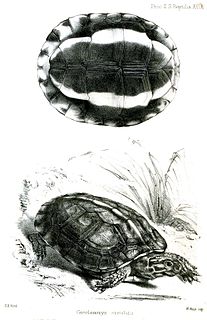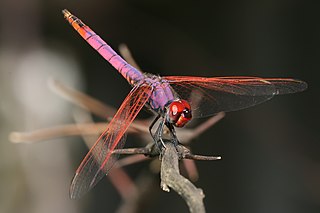The Peace of Callias is a purported treaty established around 449 BC between the Delian League and Persia, ending the Greco-Persian Wars. The peace was agreed as the first compromise treaty between Achaemenid Persia and a Greek city.
Callias was an Ancient Greek statesman, soldier and diplomat, active in 5th century BC. He is commonly known as Callias II to distinguish him from his grandfather, Callias I, and from his grandson, Callias III, who apparently squandered the family's fortune.
Hipponicus was an Athenian military commander. He was the son of Callias II and the father of Callias III. His daughter Hipparete was the wife of Alcibiades. Together with Eurymedon he commanded the Athenian forces in the incursion into Boeotian territory and was slain at the Battle of Delium (424).

The banded cat-eyed snake is a species of medium-sized, mildly venomous, colubrid snake endemic to the New World.
Callias was an ancient Athenian aristocrat and political figure. He was the son of Hipponicus and the daughter of Megacles, an Alcmaeonid and the third member of one of the most distinguished Athenian families to bear the name of Callias. He was regarded as infamous for his extravagance and profligacy.
Callias of Chalcis, son of Mnesarchus, together with his brother Taurosthenes, succeeded his father as tyrants of Chalcis. Callias formed an alliance with Philip of Macedon against Plutarch, tyrant of Eretria, with the view of extending his authority over the whole of Euboea, a design which, according to Aeschines, he disguised as a plan for uniting in one league the states of the island and establishing a general Euboean congress based at Chalcis.

There are different kinds of fictional Giants appearing in American comic books published by Marvel Comics. The most popular of the Giants are the Giants of Jotunheim, a fictional race of people based on the giants of actual Norse legends.

Theileria is a genus of parasites that belongs to the phylum Apicomplexa, and is closely related to Plasmodium. Two Theileria species, T. annulata and T. parva, are important cattle parasites. T. annulata causes tropical theileriosis and T. parva causes East Coast fever. Theileria species are transmitted by ticks. The genomes of T. orientalis Shintoku, Theileria equi WA, Theileria annulata Ankara and Theileria parva Muguga have been sequenced and published.

The brown wood turtle or brown land turtle is a species of turtle in the family Geoemydidae. The species is endemic to Central America and northern South America.

Trithemis annulata, known commonly as the violet dropwing, violet-marked darter, purple-blushed darter or plum-coloured dropwing, is a species of dragonfly in the family Libellulidae. It is found in most of Africa, in the Middle East, in the Arabian Peninsula and southern Europe. These insects are called dropwings because of their habit of immediately lowering their wings after landing on a perch. Males of this species are violet-red with red veins in the wings while females are yellow and brown. Both sexes have red eyes.
Callias, sometimes called by the nickname Schoenion (Σχοινίων), was a poet of the Old Comedy, not to be confused with the three Athenian aristocrats named Callias, the last of which, Callias III, appears in Plato's Protagoras.
Hermogenes was an ancient Athenian philosopher best remembered as a close friend of Socrates as depicted by Plato and Xenophon.
Callias was the head of a wealthy Athenian family.

Anne-Marie Gaillard, known as Nina de Villard de Callias, Nina de Callias or Nina de Villard, was a French writer and poet.

Naja annulata, commonly known as the banded water cobra or the ringed water cobra, is a species of water cobra native to western and central Africa. The species is one of the two species of water cobras in the world, the other one being the Congo water cobra.

Nyctemera annulata, commonly known as the magpie moth, is a moth of the family Erebidae. It is endemic to New Zealand and found in all parts of the country.

Erebia callias, the Colorado alpine, is a member of the Satyridae subfamily of the Nymphalidae butterflies. It is found in alpine areas of Wyoming and Colorado in the U.S. Rocky Mountains as well as various mountain ranges in eastern Asia.
This article lists the various snakes of Australia which live in a wide variety of habitats around the continent. The amethystine python or scrub python is considered Australia's largest native snake.
Calliini is a tribe of longhorn beetles of the Lamiinae subfamily.
Callia is a genus of longhorn beetles of the subfamily Lamiinae.










